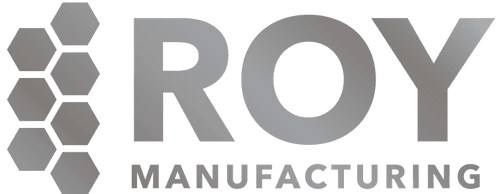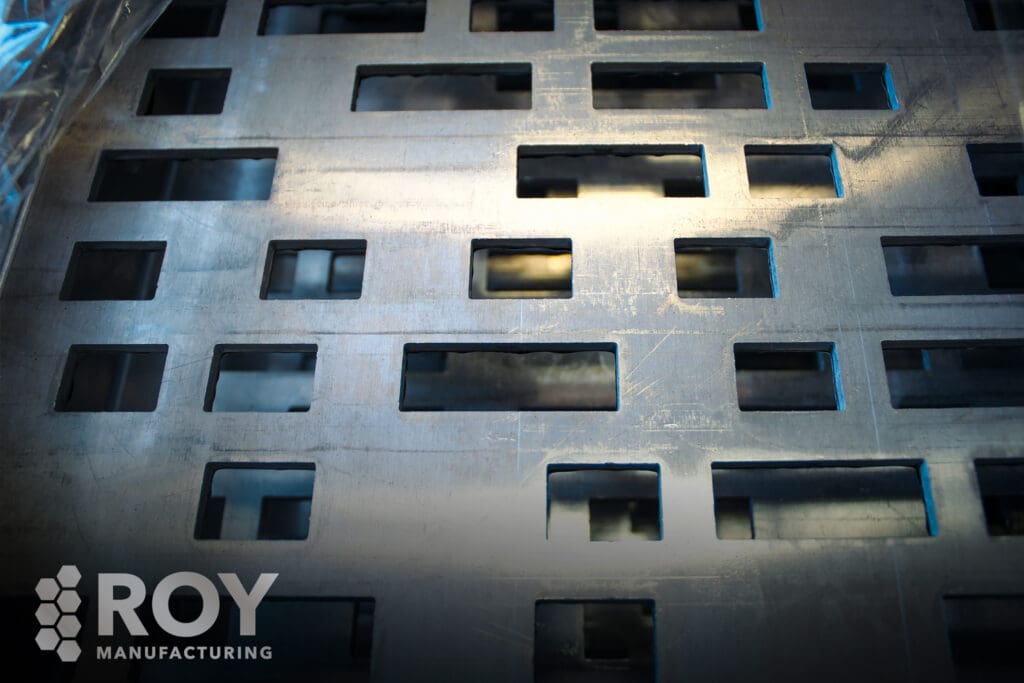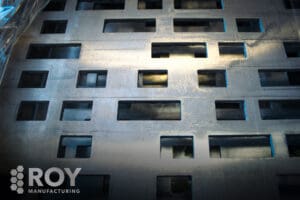Choosing the Right Pattern for Perforated Metal
Perforated metal offers a blend of functionality and aesthetics for a variety of projects, from architectural facades to industrial applications. However, choosing the right pattern for perforated metal can be a daunting task, as many factors affect the material’s structural integrity, performance, and appearance. Understanding these elements will help you make an informed decision and optimize your project outcomes.
In this article, we’ll explore the key considerations for choosing the ideal perforated metal pattern, including hole shape, material type, and percentage of open area. We’ll also discuss how different shapes impact the structural integrity and characteristics of the metal sheet and how you can use tools, like Roy Manufacturing’s open-air calculator, to ensure you’re making the best choice for your specific needs.
Key Elements to Consider for Your Perforated Metal Pattern
1. Purpose and Application
Your project’s purpose is the first consideration when selecting a perforated metal pattern. Whether you’re designing an architectural façade, soundproofing walls, or creating a filtration system, different applications will require specific hole shapes, patterns, and material thicknesses. For example:
- Ventilation and Filtration: If your primary goal is airflow or filtration, you’ll want a pattern with a high open area percentage. Larger or more frequent perforations will allow for greater airflow, but you’ll need to consider how this impacts the material’s strength.
- Aesthetic Design: In architectural applications, the perforation pattern’s visual appeal can be as crucial as its function. Patterns such as decorative holes, squares, or custom designs are popular here.
- Structural Support: If structural integrity is crucial, smaller holes or patterns with less open area might be ideal for maintaining strength while allowing airflow or visibility.
2. Hole Shape and Pattern
The hole shape and the overall pattern are pivotal in determining the aesthetic appeal and the functional properties of the perforated sheet. Each shape has its own advantages and disadvantages regarding structural strength, appearance, and how it interacts with the surrounding elements (e.g., air, light, and sound). Some common shapes include:
- Round Holes: The most commonly used hole shape, round perforations offer a good balance between structural integrity and open area. Round holes are ideal for applications requiring strength and ventilation, such as security screens or soundproofing materials.
- Square Holes: These offer a modern and geometric aesthetic while providing high open area percentages. However, square perforations can reduce the sheet’s overall strength compared to round holes. They work well in decorative applications or when larger holes are required for visibility.
- Slotted Holes: These elongated holes allow for greater airflow or drainage, making them ideal for filtration, grilles, or screens. However, slotted patterns can affect the sheet’s strength more than round holes due to the elongated shape.
- Hexagonal Holes: For applications requiring maximum open area, hexagonal patterns are a great choice. They offer higher airflow or light transmission but may compromise the material’s structural strength if the holes are too large or too close together.
The pattern’s arrangement also affects how the perforations distribute stress across the sheet. Staggered patterns provide better structural support than straight or grid patterns because the forces are spread more evenly.
3. Open Area Percentage
Open area refers to the percentage of the perforated sheet that is open space, typically created by the holes. The open area percentage is a critical factor in determining the sheet’s functionality for ventilation, filtration, or even aesthetics. For example:
- High Open Area (50-70%): This is ideal for applications that require airflow, light, or sound transmission, such as HVAC systems, acoustic panels, or sunshades.
- Low Open Area (10-30%): Suitable for projects requiring more structural strength and security, such as fencing, enclosures, or protective panels.
However, the higher the open area percentage, the weaker the sheet becomes, which is why finding the right balance is crucial. Roy Manufacturing offers an open air calculator on our website, which allows you to input hole size, spacing, and material thickness to determine the exact open area percentage. This tool is especially helpful when you’re trying to meet specific design or functional requirements.
4. Material Thickness and Type
The thickness of the material plays a significant role in determining how the perforated metal will perform under stress. Thicker materials provide better durability and structural integrity but may limit the percentage of open area you can achieve. Thinner sheets allow for higher open area percentages but may require additional support if strength is needed.
Additionally, the type of material you choose affects how well the perforated sheet can withstand environmental conditions, such as corrosion, temperature changes, or physical impact. For example:
- Stainless Steel: Resistant to corrosion and strong, making it ideal for outdoor or industrial applications.
- Aluminum: Lightweight and corrosion-resistant, often used in architectural projects or applications where weight is a concern.
- Carbon Steel: Strong but more susceptible to rust, typically used in heavy-duty applications where appearance isn’t as important.
- Galvanized Steel: Offers enhanced corrosion resistance due to its protective zinc coating, often used for outdoor or wet environments.
By considering the material type in conjunction with the hole pattern, you can optimize the strength, longevity, and aesthetic of your perforated metal project.
 Structural Integrity and Hole Pattern Impact
Structural Integrity and Hole Pattern Impact
The hole pattern you choose will impact the appearance of the metal sheet and its structural integrity. Round holes, for instance, distribute stress more evenly, allowing the sheet to maintain its strength better than other shapes. Slotted holes or large, irregularly spaced shapes may concentrate stress in certain areas, leading to potential weaknesses, especially if the metal is thin.
The pattern’s layout also plays a role. Staggered patterns, where the holes are offset, provide better structural stability than straight patterns, where the holes line up in a grid. This makes staggered patterns more suitable for load-bearing applications, while straight patterns are often preferred for aesthetic purposes.
Maximize Efficiency with Roy Manufacturing’s Open Air Calculator
Making precise calculations about your perforated metal sheet’s open area can be tricky, especially when balancing functional and aesthetic goals. We provide an open air calculator on our website to make this easier. By inputting hole size, spacing, and material thickness, you can quickly determine the percentage of open area and ensure your design will meet the necessary criteria for airflow, light transmission, and structural integrity.
Using this tool can help you avoid costly mistakes and ensure your project stays within budget while still achieving its performance and design goals.
Choosing the Best Pattern for Perforated Metal is Simple with Roy Manufacturing
Choosing the right pattern for perforated metal requires careful consideration of multiple factors, including the shape of the holes, the open area percentage, material thickness, and the project’s intended purpose. Whether you’re optimizing for strength, airflow, or aesthetics, understanding how these elements interact is critical to selecting the best pattern.
By leveraging tools like Roy Manufacturing’s open air calculator, you can confidently choose a pattern that meets your functional and aesthetic requirements. Contact our Roy Manufacturing team today for additional guidance to ensure your perforated metal project is a complete success.

 Structural Integrity and Hole Pattern Impact
Structural Integrity and Hole Pattern Impact